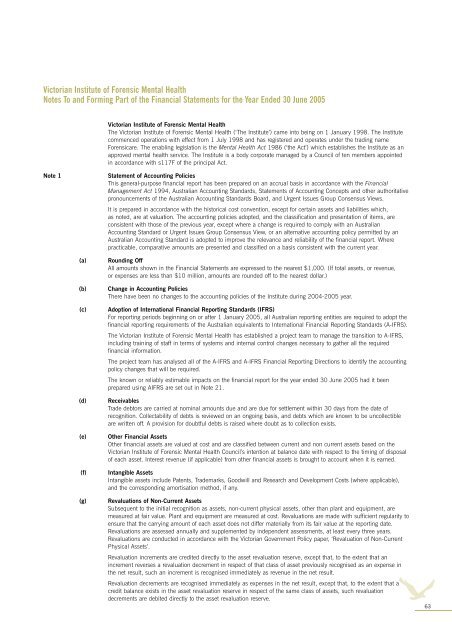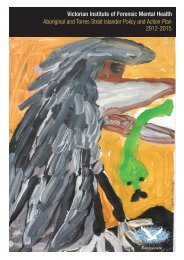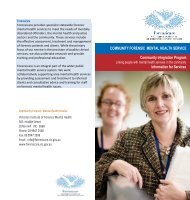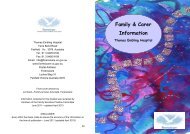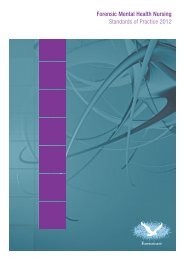Annual Report 2004-2005 - Forensicare
Annual Report 2004-2005 - Forensicare
Annual Report 2004-2005 - Forensicare
You also want an ePaper? Increase the reach of your titles
YUMPU automatically turns print PDFs into web optimized ePapers that Google loves.
Victorian Institute of Forensic Mental Health<br />
Notes To and Forming Part of the Financial Statements for the Year Ended 30 June <strong>2005</strong><br />
Victorian Institute of Forensic Mental Health<br />
The Victorian Institute of Forensic Mental Health (‘The Institute’) came into being on 1 January 1998. The Institute<br />
commenced operations with effect from 1 July 1998 and has registered and operates under the trading name<br />
<strong>Forensicare</strong>. The enabling legislation is the Mental Health Act 1986 (‘the Act’) which establishes the Institute as an<br />
approved mental health service. The Institute is a body corporate managed by a Council of ten members appointed<br />
in accordance with s117F of the principal Act.<br />
Note 1<br />
Statement of Accounting Policies<br />
This general-purpose financial report has been prepared on an accrual basis in accordance with the Financial<br />
Management Act 1994, Australian Accounting Standards, Statements of Accounting Concepts and other authoritative<br />
pronouncements of the Australian Accounting Standards Board, and Urgent Issues Group Consensus Views.<br />
It is prepared in accordance with the historical cost convention, except for certain assets and liabilities which,<br />
as noted, are at valuation. The accounting policies adopted, and the classification and presentation of items, are<br />
consistent with those of the previous year, except where a change is required to comply with an Australian<br />
Accounting Standard or Urgent Issues Group Consensus View, or an alternative accounting policy permitted by an<br />
Australian Accounting Standard is adopted to improve the relevance and reliability of the financial report. Where<br />
practicable, comparative amounts are presented and classified on a basis consistent with the current year.<br />
(a)<br />
(b)<br />
(c)<br />
(d)<br />
(e)<br />
(f)<br />
(g)<br />
Rounding Off<br />
All amounts shown in the Financial Statements are expressed to the nearest $1,000. (If total assets, or revenue,<br />
or expenses are less than $10 million, amounts are rounded off to the nearest dollar.)<br />
Change in Accounting Policies<br />
There have been no changes to the accounting policies of the Institute during <strong>2004</strong>-<strong>2005</strong> year.<br />
Adoption of International Financial <strong>Report</strong>ing Standards (IFRS)<br />
For reporting periods beginning on or after 1 January <strong>2005</strong>, all Australian reporting entities are required to adopt the<br />
financial reporting requirements of the Australian equivalents to International Financial <strong>Report</strong>ing Standards (A-IFRS).<br />
The Victorian Institute of Forensic Mental Health has established a project team to manage the transition to A-IFRS,<br />
including training of staff in terms of systems and internal control changes necessary to gather all the required<br />
financial information.<br />
The project team has analysed all of the A-IFRS and A-IFRS Financial <strong>Report</strong>ing Directions to identify the accounting<br />
policy changes that will be required.<br />
The known or reliably estimable impacts on the financial report for the year ended 30 June <strong>2005</strong> had it been<br />
prepared using AIFRS are set out in Note 21.<br />
Receivables<br />
Trade debtors are carried at nominal amounts due and are due for settlement within 30 days from the date of<br />
recognition. Collectability of debts is reviewed on an ongoing basis, and debts which are known to be uncollectible<br />
are written off. A provision for doubtful debts is raised where doubt as to collection exists.<br />
Other Financial Assets<br />
Other financial assets are valued at cost and are classified between current and non current assets based on the<br />
Victorian Institute of Forensic Mental Health Council’s intention at balance date with respect to the timing of disposal<br />
of each asset. Interest revenue (if applicable) from other financial assets is brought to account when it is earned.<br />
Intangible Assets<br />
Intangible assets include Patents, Trademarks, Goodwill and Research and Development Costs (where applicable),<br />
and the corresponding amortisation method, if any.<br />
Revaluations of Non-Current Assets<br />
Subsequent to the initial recognition as assets, non-current physical assets, other than plant and equipment, are<br />
measured at fair value. Plant and equipment are measured at cost. Revaluations are made with sufficient regularity to<br />
ensure that the carrying amount of each asset does not differ materially from its fair value at the reporting date.<br />
Revaluations are assessed annually and supplemented by independent assessments, at least every three years.<br />
Revaluations are conducted in accordance with the Victorian Government Policy paper, ‘Revaluation of Non-Current<br />
Physical Assets’.<br />
Revaluation increments are credited directly to the asset revaluation reserve, except that, to the extent that an<br />
increment reverses a revaluation decrement in respect of that class of asset previously recognised as an expense in<br />
the net result, such an increment is recognised immediately as revenue in the net result.<br />
Revaluation decrements are recognised immediately as expenses in the net result, except that, to the extent that a<br />
credit balance exists in the asset revaluation reserve in respect of the same class of assets, such revaluation<br />
decrements are debited directly to the asset revaluation reserve.<br />
63


